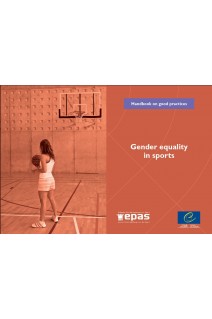



Since the Enlarged Partial Agreement on Sport (EPAS) was set up in 2007, one of its major
priorities has been the promotion of diversity in and through sport. To this end, the Council
of Europe has developed a pan-European programme involving a variety of stakeholders from
public authorities and the world of sport. All have an important role to play in reversing
the discriminatory trends currently observed in sport and in promoting sport as a means
of fostering diversity and social cohesion.
This collection of handbooks of good practices is an illustration of current policies and
practices throughout Europe. Its aim is to disseminate and share positive experiences
highlighting the potential of sport for promoting the Council of Europe’s fundamental
values of human rights.
Foreword ...................................................................................................5
Introduction ............................................................................................7
1. Physical and sports activities and the gender issue
in Europe ..............................................................................................9
1.1. Girls/Boys and Women/Men: separate sporting worlds ..........9
1.2. Disparities and inequalities among girls and women ............ 12
1.3. The main obstacles to participating in sport........................... 13
2. Overview of good practices in Europe ................................ 19
“Midnight Sport” and “Open Sunday”: opening up
sports facilities to young people at the weekend
(Switzerland) ..................................................................................... 20
A guide to gender mainstreaming for local sports
policies (Spain) ................................................................................. 21
The association Elan sportif: promoting boxing
for women (France) ........................................................................ 22
“The Kick for Girls” (Der Kick für Mädchen – Fußball)
school project (Germany) ............................................................. 23
The SheZone association: combining sport and social
activities for women (Denmark)................................................... 24
The “Widening Access Through Sport (WATS)”
programme (United Kingdom) ..................................................... 25
Participation in organised physical activities – a means
for women to fight stress (Bosnia and Herzegovina) .............. 26
The activities of the Slovak Olympic Committee’s
“Women and Sport” Commission (Slovakia) ............................ 27
3. Recommendations ........................................................................ 29
Bibliography .......................................................................................... 33
Editorial team ..................................................................................... 37

Since the Enlarged Partial Agreement on Sport (EPAS) was set up in 2007, one of its major
priorities has been the promotion of diversity in and through sport. To this end, the Council
of Europe has developed a pan-European programme involving a variety of stakeholders from
public authorities and the world of sport. All have an important role to play in reversing
the discriminatory trends currently observed in sport and in promoting sport as a means
of fostering diversity and social cohesion.
This collection of handbooks of good practices is an illustration of current policies and
practices throughout Europe. Its aim is to disseminate and share positive experiences
highlighting the potential of sport for promoting the Council of Europe’s fundamental
values of human rights.
